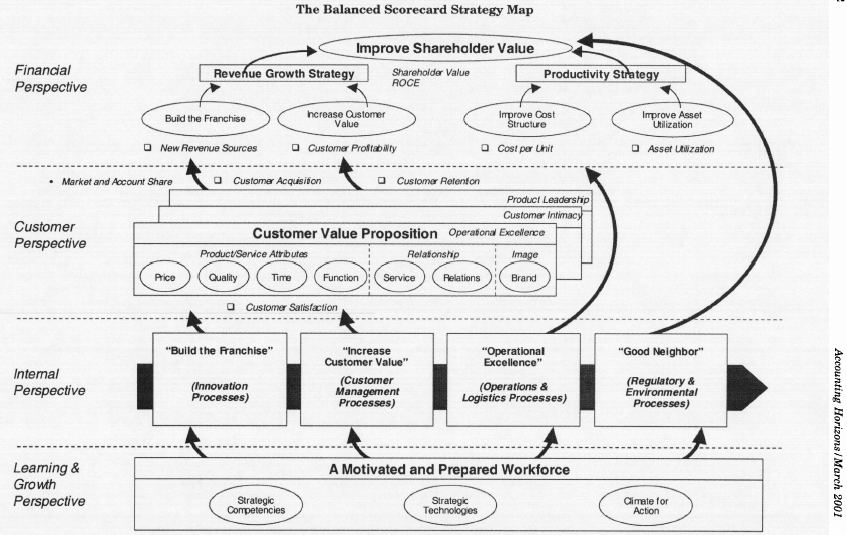
Image source: Lorenzo Lucianetti
The Balanced Scorecard Model is a strategic management tool developed by Robert Kaplan and David Norton in 1996. The model helps organizations to align their activities with their strategic goals, monitor performance, and make informed decisions. The Balanced Scorecard Model is based on the premise that a company’s performance should be measured from four different perspectives: financial, customer, internal processes, and learning and growth.
Financial Perspective:
This perspective measures the company’s financial performance, including revenue, profitability, and return on investment (ROI). It focuses on how the company creates value for its shareholders. Examples of financial metrics include net income, return on equity (ROE), and cash flow.
Customer Perspective:
This perspective measures how well the company is satisfying its customers’ needs and expectations. It focuses on customer satisfaction, loyalty, and retention. Examples of customer metrics include customer satisfaction surveys, customer retention rates, and customer complaints.
Internal Processes Perspective:
This perspective measures the company’s internal business processes and operations. It focuses on how the company can improve its efficiency, productivity, and quality. Examples of internal process metrics include cycle time, defect rate, and process improvement initiatives.
Learning and Growth Perspective:
This perspective measures the company’s ability to innovate and learn. It focuses on employee development, training, and knowledge management. Examples of learning and growth metrics include employee satisfaction, training hours per employee, and percentage of employees with advanced degrees.
To use the Balanced Scorecard Model, an organization should follow these steps:
Identify strategic objectives:
The organization should identify its strategic objectives and goals. These objectives should be specific, measurable, achievable, relevant, and time-bound (SMART).
Develop performance indicators:
The organization should develop performance indicators for each perspective of the Balanced Scorecard. These indicators should be aligned with the organization’s strategic objectives.
Set targets:
The organization should set targets for each performance indicator. These targets should be challenging but achievable.
Implement and monitor:
The organization should implement the Balanced Scorecard Model and monitor its performance regularly. The organization should use the performance indicators to measure its progress towards achieving its strategic objectives.
Example of using the Balanced Scorecard Model:
Let’s consider a retail company that wants to use the Balanced Scorecard Model. The company’s strategic objectives may include the following:
Financial Perspective:
Increase revenue and profitability by 10% in the next year.
Customer Perspective:
Improve customer satisfaction ratings by 20% in the next year.
Internal Processes Perspective:
Reduce inventory holding costs by 15% in the next year.
Learning and Growth Perspective:
Increase employee training hours by 25% in the next year.
The company would develop performance indicators for each perspective of the Balanced Scorecard, such as:
Financial Perspective:
- Revenue growth rate
- Gross margin percentage
- Net profit margin
Customer Perspective:
- Customer satisfaction rating
- Net promoter score
- Customer retention rate
Internal Processes Perspective:
- Inventory turnover rate
- Cycle time
- Productivity rate
Learning and Growth Perspective:
- Employee training hours
- Employee turnover rate
- Employee satisfaction rate
The company would set targets for each performance indicator, such as:
Financial Perspective:
- Revenue growth rate: 10%
- Gross margin percentage: 30%
- Net profit margin: 5%
Customer Perspective:
- Customer satisfaction rating: 80%
- Net promoter score: 30%
- Customer retention rate: 90%
Internal Processes Perspective:
- Inventory turnover rate: 8 times per year
- Cycle time: 2 days
- Productivity rate: 95%
Learning and Growth Perspective:
- Employee training hours: 50 hours per employee per year
- Employee turnover rate: less than 10%
- Employee satisfaction rate: 80%
The company would then implement the Balanced Scorecard Model and monitor its performance regularly. For example, the company could use a dashboard to track the performance of each perspective of the Balanced Scorecard. The dashboard could include graphs and charts that show the company’s progress towards achieving its strategic objectives.
By using the Balanced Scorecard Model, the retail company can align its activities with its strategic goals, monitor performance, and make informed decisions. The model helps the company to focus on the most important areas of its business and ensure that it is achieving its objectives. For example, if the company is not meeting its target for customer satisfaction, it may need to invest in customer service training or improve its product quality to meet customer expectations.
The following video offers more insight into the Balanced Scorecard Model with examples:
